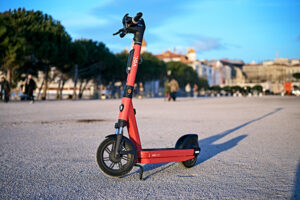Bike Infrastructure in Bonn
As we’ve been taking classes here in Bonn the train is typically my preferred mode of travel. The infrastructure is fantastic and even when they’re running behind travel is incredibly easy without a car. One thing that we rarely deal with in the United States however, are train strikes. We’ve lost two days of class to train strikes this semester and without the trains I’ve become familiar with the biking infrastructure, utilizing bike paths with rental electric scooters.
12 mph on 2 wheels
During these strikes and late at night when trains only run once an hour if at all, I’ve started using Voi and Lime scooters to navigate the city.

Found on sidewalks unattended all they require is a scan on the Voi or Uber app and you’re off. They’re quite cheap, charging 0.5-1 Euro to unlock them and an additional 0.2 Euro a minute you use them. They’re quite fast reaching 20kmh or about 12 mph and offer a cheap and quick way to get around when faced with trouble on the train. These scooters turn what would be a travel induced headache into 10 minutes of fun as you get from point A to point B and finally stop the ride and leave the scooters wherever you’d like on the sidewalks.
Utilizing Bike Infrastructure
As the scooters are quite fast you aren’t supposed to use them on the sidewalk unless you’re interesting in bowling through a family of 5. Thankfully the infrastructure for bikes is incredible here with bike lanes clearly marked everywhere and markings on the street for where to stop as you occasionally cut through traffic. It all feels very bike centric as although one may feel unsafe faced with the idea of such a small vehicle keeping pace with traffic, the lanes feel surprisingly secure. This comes as no surprise however when you consider “30% of Germans regularly bike to work” compared to only 0.5% in the United States (Marshall). The bike lanes are very respected here with pedestrians and traffic alike doing all they can to stay out of them. My first couple hours here in Germany my host family walked me home and I was accidentally walking on the biking side of the sidewalk. Noticing this, one of them told me that the bikes will not stop for me and may run me over with no hesitation. This came as a shock to me as my whole life cyclists were the last concern of most people on thew road. They were almost expected to figure it out when people or cars are in their way and they seem to be commonly demonized in my hometown. When I started to utilize these lanes I found it was incredibly easy. Although I know nothing of traffic laws here I was easily able to navigate the lanes and roads in a safe manner. Part of why they’re so safe here is it seems Germans are very strict following the rules laid out. Rarely will you see someone speed up to make a yellow light or cross a road when the sign doesn’t instruct them to do so. this contrasts heavily with the norm in the US where “you’ll regularly see pedestrians ignore traffic intersection signals” (Marshall). In Berlin especially the crossing signs have become beloved by the people living there as they became a symbol for the city.

How the US Can Change
Increased infrastructure for bikes has been a fairly controversial topic in the United States recently. Concerning Cambridge specifically a group of residents fight against bike lanes stating that it would hurt small businesses due to the loss of parking along the road (Nagatomi, Rai). Some residents also noted that increased bike traffic could pose a threat to pedestrians and harm foot traffic in the area. Such are the problems that many looking to increase bike infrastructure in the United States face as many people oppose them due to uninformed preconceptions on bike lanes. Until living here in Germany I probably sided more with those people as I didn’t realize just how much easier good bike lanes make travel in high traffic areas. As time goes on I would hope that the United States starts to adopt bike infrastructure in a manner seen in European countries but only time will tell.
-Ryan C
Marshall, John. “Germans and Their Beloved Bike Paths – DW – 10/28/2021.” Dw.com. Last modified September 20, 2021. https://www.dw.com/en/germans-and-their-beloved-bike-paths/a-59215483.
Nagatomi, Ayumi, and Avani B. Rai. “Flat Tires: How A Divisive Debate Over Cambridge Bike Lanes Left Everyone Unsatisfied.” The Harvard Crimson. Accessed February 24, 2025. https://www.thecrimson.com/article/2024/5/23/bike-lanes-politics-feature/.
